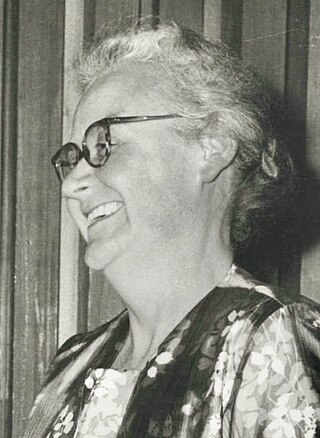
Dame Caroline Harriet Haslett DBE, JP was an English electrical engineer, electricity industry administrator and champion of women's rights.
Evangelia Micheli-Tzanakou was a professor of biomedical engineering and the Director of Computational Intelligence Laboratories at Rutgers University. Dr. Micheli-Tzanakou was also a Founding Fellow of the American Institute for Medical and Biological Engineering (AIMBE), a Fellow of the Institute of Electrical and Electronics Engineers (IEEE), and a Fellow of the New Jersey Academy of Medicine. Dr. Micheli-Tzanakou's areas of interest included neural networks, information processing in the brain, image and signal processing applied to biomedicine, telemedicine, mammography, hearing aids and electronic equivalents of neurons. Dr. Micheli-Tzanakou received international attention in 1974 when she established the first Brain to Computer Interface (BCI) using her algorithm ALOPEX. This method was used in the study of Parkinson's disease. The ALOPEX algorithm has also been applied toward signal processing, image processing, and pattern recognition. Dr. Micheli-Tzanakou died on September 24, 2012, after a long fight with cancer.

The Women's Engineering Society is a United Kingdom professional learned society and networking body for women engineers, scientists and technologists. It was the first professional body set up for women working in all areas of engineering, predating the Society of Women Engineers by around 30 years.

Gertrude Lilian Entwisle was an electrical engineer. She was the first British woman to retire from a complete career in industry as a professional engineer; the first female engineer to work at British Westinghouse; and the first female student, graduate, and associate member of the Institution of Electrical Engineers. Entwisle was known for her work on designing DC motors and exciters. Her obituary said she broke "barriers of prejudice to become a respected designer of electrical rotating machinery."
Proscovia Margaret Njuki is a Ugandan electrical engineer and civil servant. Effective 24 November 2016, she serves as the chairperson of the board of directors of Uganda Electricity Generation Company Limited (UEGCL). She replaced Stephen Isabalija, who was appointed permanent secretary at the Uganda Ministry of Energy and Mineral Development.
Ziria Tibalwa Waako is a Ugandan electrical engineer and corporate executive, who serves as the executive director and chief executive officer of the Electricity Regulatory Authority, since November 2016. She replaced Benon Mutambi, who was appointed the Permanent Secretary of the Uganda Ministry of Internal Affairs. For the first four months, from November 2016 until March 2017, she served in an acting capacity, until her confirmation on 27 March 2017.

Elizabeth Laverick was a British engineer who became technical director of Elliott Automation Radar Systems. Laverick was the first female deputy secretary of the Institution of Electrical Engineers and president of the Women's Engineering Society. She was the first woman to receive a PhD in a scientific curriculum at Durham University, and was appointed an OBE in 1993.

Annie "Anne" Gillespie Shaw CBE was a Scottish engineer and businesswoman. Shaw specialised in time and motion studies. In 1945, she founded the Anne Shaw Organisation Ltd, a consulting company.

Isabel Helen HardwichMInstP was an English electrical engineer, an expert in photometry, and fellow and president of the Women's Engineering Society.

Elizabeth "Betty" Audrey Killick was a British naval electronics engineer who worked on radar and weapons systems for the Ministry of Defence. In 1982, she became the first woman to be elected a Fellow of the Royal Academy of Engineering.
The Electrical Association for Women (EAW) was a feminist and educational organisation founded in Great Britain in 1924 to promote the benefits of electricity in the home.
Ben Mary Muwanga (sometimes referred to as Benny Muwanga or Mary Ben Muwanga is a Ugandan netball coach most notable for leading the She Cranes to the 1979 Netball World Championships in Trinidad and Tobago. She was also the national team coach between 1975 - 1985.
Winifred Hackett was an electrical and aeronautical engineer who worked on guided weapon systems and the DEUCE computer.
Women have played a role in engineering in the United Kingdom for hundreds of years, despite the various societal barriers facing them. In the 18th and 19th century, there were few formal training opportunities for women to train as engineers and frequently women were introduced to engineering through family companies or their spouses. Some women did have more formal educations in the late 19th century and early 20th century, normally in mathematics or science subjects. There are several examples of women filing patents in the 19th century, including Sarah Guppy, Henrietta Vansittart and Hertha Ayrton.
Marja "Maria" Ludwika Watkins was a defence electronics engineer, lecturer and President of the Women's Engineering Society.
ICWES is an international conference for engineers and scientists. Established in 1964, it takes place every 3–4 years in countries around the world.

Dorothy Smith was a British electrical engineer. She worked for the engineering firm Metropolitan-Vickers from 1916 to 1959, retiring after forty-three years at the company. She was the second woman to gain Full Membership of the Institution of Electrical Engineers since Hertha Ayrton in 1899 and was a prominent member of the Manchester branch of the Women's Engineering Society.
Lesley Scott Souter was the first female electrical engineering student at the University of Glasgow, graduating in 1940.
Gwendolen Sergant was a Major and engineer in the Women's Royal Army Corps for over twenty years, serving with the Royal Electrical and Mechanical Engineers. One of her appointments involved being in charge of the British army's whole fleet of 160,000 vehicles. She was President of the Women's Engineering Society from 1974 to 1975.
Veronica “Ronnie” Jean Kathleen Milligan was an electrical engineer with expertise in construction management and president of the Women's Engineering Society.








